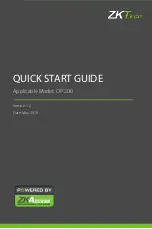
Pub. No. 1210 - April 2016
7
RITE-HITE
®
RHH-4000 Dock Leveler Owner’s Manual
OWNER RESPONSIBILITY
1.
The owner should recognize the inherent danger of the
interface between dock and transport vehicle. The owner
should, therefore, train and instruct operators in the safe use
of dock equipment in accordance with the information
provided below. The manufacturer shall publish, provide to the
initial purchaser, and make the following information readily
available to owners:
•
Installation instructions
•
Recommended initial and periodic inspections procedures
•
Maintenance procedures
•
Operating instructions
•
Descriptions or specifications for replaceable or repairable
parts
•
Tables identifying the grade (slope) for all variations of
length or configuration of the dock equipment, and
•
Information identifying the maximum uncontrolled drop
encountered upon sudden removal of support while within
the working range of the equipment.
It shall be the responsibility of the owner to verify that the
material listed in this section has been received and that it is
made available for the instruction and training of presonnel
entrusted with the use or maintenance of the dock equipment.
2.
When a transport vehicle is parked at a loading dock, it is
important that the vehicle is relatively perpendicular to the
dock face and in close contact with at least one of the dock
bumpers.
3.
Nameplates, cautions, instructions, and posted warnings shall
not be obscured from the view of operating or maintenance
personnel for whom such warnings are intended.
4.
Manufacturer’s recommended periodic maintenance and
inspection procedures in effect at date of shipment shall be
followed, and written records of the performance of these
procedures should be kept.
5.
As with any piece of machinery, dock equipment requires routine
maintenance, lubrication, and adjustments. Your local
RITE-HITE
®
representative offers owners the option of a
Planned Maintenance Program (P.M.P.). As part of this
service, your local RITE-HITE
®
representative will do all
routine maintenance, lubrication, and adjustments.
6.
Dock equipment that is structurally damaged shall be removed
from service, inspected by a manufacturer’s authorized
representative, and repaired as needed before being placed
back in service.
7.
The manufacturer shall make available replacement
nameplates, caution/instruction labels, and operating /
maintenance manuals upon request of the owner. The owner
shall see that all nameplates, caution/instruction markings or
labels are in place and legible, and that the appropriate
operating/maintenance manuals are provided to users.
8.
Modifications or alterations of dock equipment shall be made
only with written permission of the original manufacturer.
These changes shall also satisfy all safety recommendations
of the original equipment manufacturer for the particular
application of the dock equipment.
9.
In order to be entitled to the benefits of the standard product
warranty, the dock equipment must have been properly
installed, maintained and operated within its rated capacities
and/or specific design parameters, and not otherwise abused.
10.
It is recommended that trailers equipped with air ride
suspensions should remove the air from the suspension to
minimize trailer bed drop, prior to loading or unloading.
11.
When industrial trucks are driven on and off transport vehicles
during the loading and unloading operation, the brakes on the
transport vehicle shall be applied and wheel chocks or a
positive restraining device shall be engaged.
12.
In selecting dock equipment, it is important to consider not
only present requirements but also future plans or adverse
environments.








































